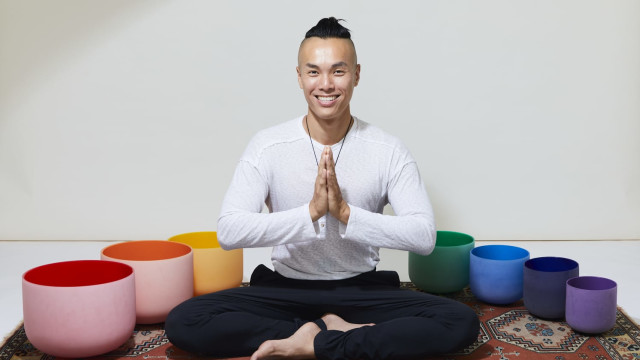Presenting My Research to The Dalai Lama

When David Vago, Ph.D., was in graduate school, mindfulness was not a hot topic. In fact, very little scholarly research had been done on the subject. Against the advice of his mentor, he decided to change that. Now a cognitive neuroscientist, Dr. Vago has written some of the most cited papers regarding mindfulness. Here, he talks the many meditation styles he’s studied, what it felt like to present his research to the Dalai Lama, and the connection between his dog and his teacher.
Q: How did you first discover meditation?
A: My first 10-day Goenka-style Vipassana course was in 1995. I was studying cognitive and neural sciences in my undergraduate studies in combination with an emphasis on religious studies. The Vipassana course provided a systematic method and profound platform from which to seriously contemplate mind — my own and in relation to others.
Q: How did you find your meditation style, and why does it work so well for you?
A: I started learning Vipassana from S.N. Goenka and the Burmese tradition. This style of meditation was rigorous and helped establish the most relevant practice that I continue to do each day — Anapanasati, or breath meditation. I did my requisite amount of exploration from other traditions, including Zen, Dzogchen which includes a variety of meditation styles used by the Nyingma school of Tibetan Buddhism, Mahamudra, and the contemporary methods of mindfulness-based stress reduction (MBSR), Compassion Cultivation Training, and Unified Mindfulness.
Each school of meditation and each teacher has provided unique opportunities for me and my spiritual progress. For example, I don’t practice Zazen or Shikantaza (sitting in silence) regularly, but I received my best training how to sit properly from my exposure to Zen. My main teacher, Chokyi Nyima Rinpoche, provides preliminary Dzogchen/Mahamudra practices to support my progress as a practitioner. I gravitate to this particular lineage and teaching due to a meaningful connection that was made between Rinpoche and my Border Collie/Lab mix, Kayla, in 2009. Ever since, I have been committed to Dzogchen/Mahamudra and the Tara’s Triple Excellence and ngöndro preliminary practices with Chokyi Nyima and Yongey Mingyur Rinpoche.
I have also been exposed to contemporary styles of practice that are very helpful adaptations for high-stress lifestyles. I now rely on concentration practice to stabilize mind, as necessary; noting and labeling practice from the Unified Mindfulness method taught by Shinzen Young to work with insight development; and Dzogchen/Mahamudra for cultivating penetrating awareness and insight.
Q: What’s your top tip for a beginning meditator?
A: Breathe! When you can’t manage your stress or can’t find time to start practice, just check in for one or two breaths. Allow yourself to find calm and stability wherever you may be by just following your breath wherever it is most salient for you and without any effort to change the breathing. Eventually, one or two breaths turns into two to five minutes, then 15 to 30 minutes, and focusing on breath becomes more effortless.
Q: Who has had the biggest impact on your work?
A: His Holiness the Dalai Lama has impacted me and my work most profoundly and most directly. I have both a personal connection to HHDL and the Gelug teachings as well as a professional connection. I have previously served as the senior scientist and senior research coordinator for the Mind & Life Institute, a nonprofit organization that includes the Dalai Lama as the honorary chairman. Without the intention of HHDL to dialogue with Western scientists, I would never have found a niche in contemplative neuroscience. He continually inspires me to practice for the sake of my own mental health and spiritual progress, but also as a form of service to relieve suffering in the world.
In 2013, as part of a Mind & Life private dialogue (Mind and Life XXIV), I had the honor to present my research directly to His Holiness the Dalai Lama along with five other scientists considered emerging leaders from around the world. His Holiness looked at each of us, wagged his finger sternly, and warned, “Now, you have the responsibility in order to build a happy, peaceful world. … I will watch you, whether you are really helping to build a happy, peaceful world or not. … Constantly check your own motivation.”
My motivation remains to impact the world through the lens of cognitive neuroscience research and education associated with meditation and mindfulness practice. I envision a future where converging scientific methodologies — including peripheral physiology, genomics, data science, neurobiological, and cognitive/behavioral testing in a “second-person” perspective — can offer comprehensive biomarkers and phenotypes to improve our fundamental understanding and real-world applications of meditation practices using relevant health technology so that collectively, humanity can move closer to flourishing and improving human suffering.
Q: What are the greatest benefits you’ve received from meditating?
A: There is a complexity that is associated with having a meditation practice; it isn’t just a quick fix to common everyday stressors. It’s a life-transformative way of being that can have profound effects on all levels and not just on attention or emotion regulation.
Humanity is plagued with social disconnection, a growing list of existential threats, and a never-ending drive for hedonic pleasure. The practice and embodiment of mindfulness and compassion offer potential skills to re-engineer and re-create ourselves so that we may overcome such threats. Our effective and efficient use of our minds and our hearts has the potential to overcome our selfish tendencies and biological limitations so that each human being alone and in collective force may be a major contributing factor to the survival and flourishing of our species. Our motivation may start as self-help, but the goal is not to sit in the corner with our eyes closed. A deeper engagement with meditation helps to facilitate a deeper sense of connection to ourselves and in relation to others.
Try this Short and Easy Breath Meditation, by David Vago, Ph.D., as you learn to build your meditation practice.
Header photo: Sylvia Becerra Gonzalez/istock/Getty Images Plus









